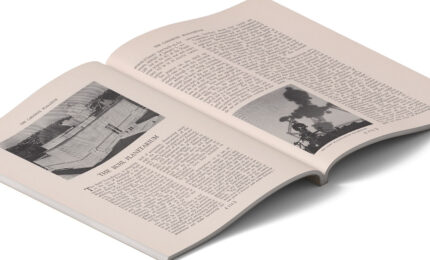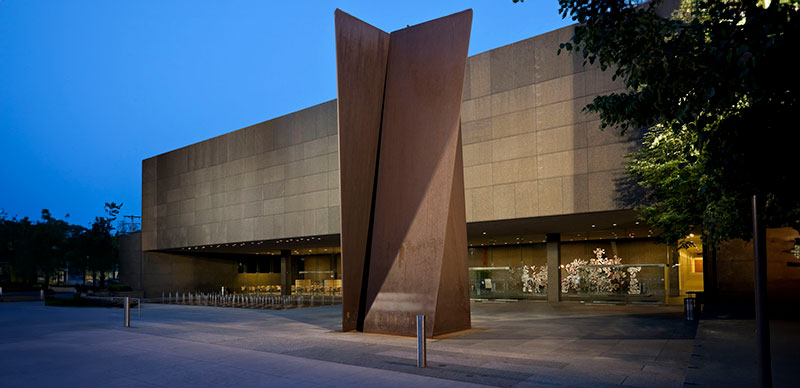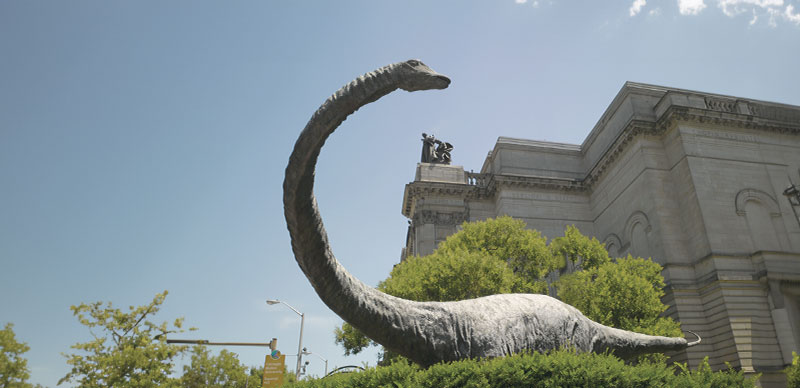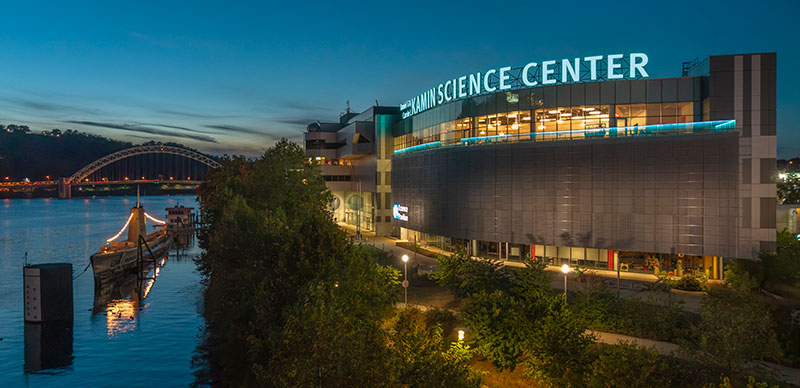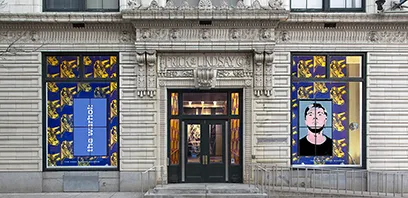Last summer, Bonnie Isaac and her husband, Joe, found themselves crawling across 90-foot bluffs above Elk Creek in Erie County, in search of a rare plant. The cliffs were as steep as they were slippery, and the pair of botanists had brought rope to tie off with—a safeguard not normally required for plant-picking. All the effort paid off when Isaac spotted a sprig of Canada buffaloberry clinging to the rocks below.
Scientifically known as Shepherdia canadensis, this small shrub is one of the rarest plants in the state, and it’s only been sighted in a handful of locations.
“It only grows in one very specific geological layer in Pennsylvania, and it’s all found on really super-steep cliffs,” says Isaac, collections manager for botany and co-chair of collections at Carnegie Museum of Natural History. “So, it’s like taking your life in your hands to go surveying for this plant.”
Going out in search of rare and fascinating plant specimens is part of Isaac’s job, a role she’s relished for 30 years. An expert on the plants of Pennsylvania, recently she’s been working under a grant from the state’s Wild Resource Conservation Program tasking her with taking stock of 10 of the state’s most endangered plant species—leading her to the bluffs.
The Canada buffaloberry that Isaac found was just out of reach and situated in such a dangerous place that taking a sample by hand was out of the question. But Joe Isaac had other ideas. He took a length of the safety rope and tied it into a small noose, lowered the rope over the edge of the cliff and down to where the uncommon shrub grew, and then looped the rope around a single branch, cinched it tight, and reeled the specimen back up.
“So it was a tiny little piece,” Isaac admits, laughing. “But I told him, ‘It’s the most beautiful specimen I’ve ever seen, because you’re still alive!’”
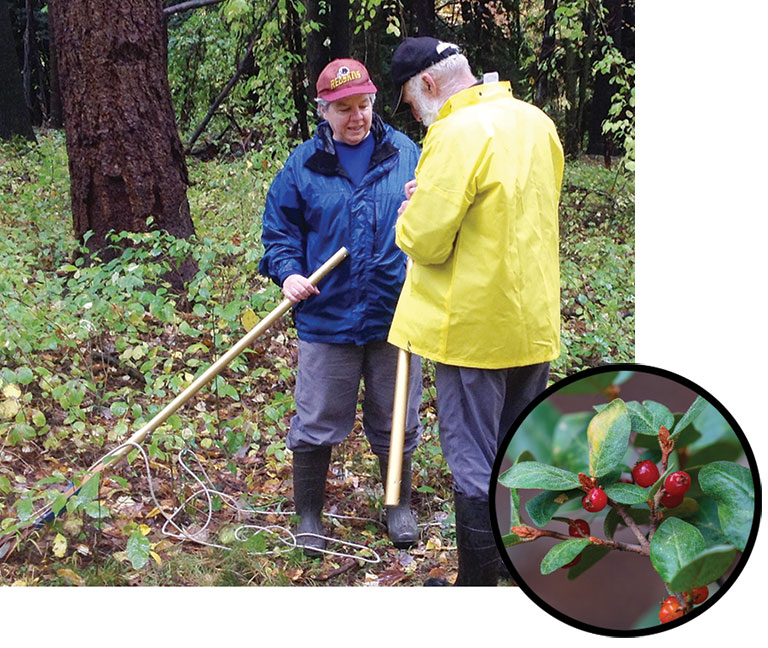
Bonnie and Joe Isaac on a plant-collecting adventure at Preston Park in Meridian, Pennsylvania. A close-up of the rare-to-Pennsylvania Canada buffaloberry, which produces edible berries.
Back at the museum, Isaac sandwiched the specimen between newspapers and dried it using a heater fan. Next, she affixed it to a placard complete with information about where it was found, when, by whom, and under what conditions. The sample was then placed among the others squirreled away inside the museum’s herbarium—a treasure trove of more than half a million leaves, buds, petals, roots, and stems that date back to the 1700s.
Most people have never heard the word herbarium, let alone walked among its stacks of records at the museum. But these archives of plant clippings are every bit as important as the Triceratops and Tyrannosaurus rex fossils on display. That’s because plants are the basis of pretty much every ecosystem on Earth, says Isaac, who holds a master’s degree in biological sciences from Youngstown State University.
Plants create the oxygen we breathe and the food we eat. They’re used to make clothes we wear, houses we live in, and medicine we depend on. Even the coal, gas, and oil used to heat our homes, power our cars, and produce our electricity comes from the fossil remains of plants that lived hundreds of millions of years ago.
By collecting samples and comparing them to what was preserved in the past, the museum’s herbarium offers scientists around the world access to a kind of botanical time machine.
“I think to understand our biological future, we need to understand what existed in the past and what currently exists,” says Mason Heberling, the museum’s assistant curator of botany and co-chair of collections. “The environment is changing at a crazy, rapid pace. As botanists, we’re capturing that change.”
Wildflowers and a warming world
Barking Slopes Biological Diversity Area near Oakmont, east of Pittsburgh, doesn’t look like much on a cold and gray December morning. A few fresh footprints pressed into the previous night’s dusting of snow hint that animals live there, but whatever birdsong there might be normally is overpowered by the train whistles that ring out every few minutes. Barges ply the Allegheny River a stone’s throw away from the trail, and across the way, smokestacks from the Cheswick Generating Station glow through the leafless trees.
But even in this place, life lies in wait.
“As early as March, this whole area will be covered with a spring beauty called Claytonia,” says Heberling, who holds a doctorate in biology from Syracuse University. “It’s quite striking.”
In addition to these tiny but prominent white and pink petals, Barking Slopes, named for its steep cliffs, is home to stunning forest wildflowers such as the yellow-petaled trout lily (Erythronium americanum), the delicate-looking hanging bells of Solomon’s seal (Polygonatum biflorum), and a plant named dwarf larkspur (Delphinium tricorne), which produces gorgeous stalks of purple flowers that would look all too at home in a bouquet. Don’t pick them, though. Many native forest wildflowers are in decline and protected by law.
Amazingly, Heberling says this place—sandwiched between a cliff and a railroad track and surrounded by urban development—sports one of the highest diversities of wildflower species in southwestern Pennsylvania. Which is why he’s so keen to study it, thanks to a new grant from the National Science Foundation.
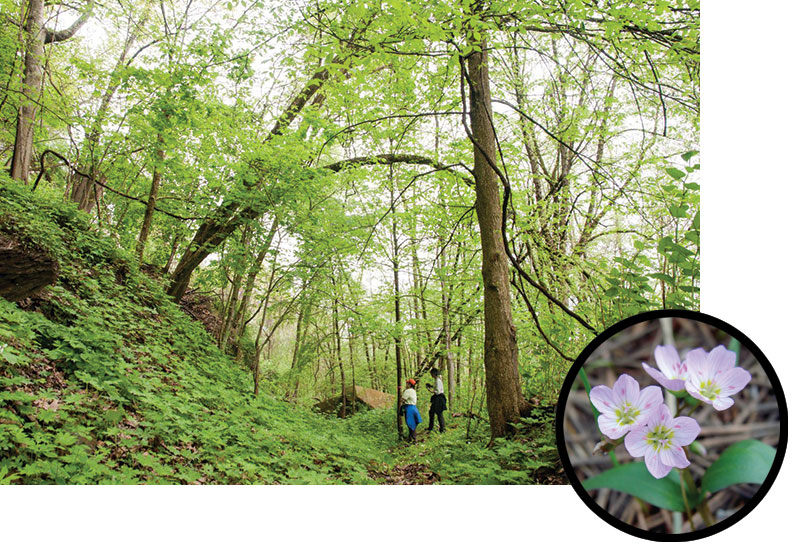
Geographically unique Barking Slopes in bloom and a close-up of Claytonia, one of the spring beauties that grows there. Below, phlox collected from Armstrong County in 1961.
While wildflowers can appear frail, many species are perennial, and some, like the three-petaled trillium species, can live 100 years or more. “They’re really slow-growing,” says Heberling. “It can take 10 years before a trillium flowers for the first time.”
At the same time, many wildflowers are inextricably tied to the onset of spring. These plants rise out of the soil earlier than other plants, completing much of their life cycle before trees and other tall plants leaf out, eventually blocking out the sun. All of which raises the question: If spring is arriving earlier every year on account of climate change, what effect will that have on the wildflowers that are primed to follow it? Heberling and his collaborators have used historic datasets to begin answering just that.
“On an average, wildflowers tend to leaf out and flower about a week earlier than they did in the 1850s,” says Heberling. “But trees, as a group, seem to leaf out two weeks earlier.”
“The environment is changing at a crazy, rapid pace. As botanists, we’re capturing that change.” – Mason Heberling, plant ecologist and Carnegie Museum assistant curator of botany
This means that wildflowers may now be getting an entire week less of sunlight than they did in the past—a big deal for plants that only have a few weeks each year to grow. This is what scientists call a phenological mismatch—when climate change screws up the coordination of timing patterns plants and animals have developed over thousands of years of evolution.
So far, scientists aren’t really sure why wildflowers and trees are responding differently to a warming world. But it might have something to do with how the plants experience temperature. Trees lose their leaves each winter, but they retain their trunks and branches, while perennial wildflowers shrink back into the soil. This means one is exposed to all the whims of weather while the other is somewhat buffered. Trees, in other words, may be better able to detect the arrival of spring than plants that hide out underground.
Invasive species may also play a role in whatever’s going on, and Barking Slopes is home to many of them. After just five minutes on the trail, Heberling identified sprigs of wasabi-scented garlic mustard, hay-like Japanese stiltgrass, a shrub named privet, and the multiflora rose, often referred to locally as a “jagger bush.” And then there’s the knotweed, a plant that can grow 12 feet high, which allows it to dominate the undergrowth once it takes hold. At every turn of the trail, Heberling pointed to another stand of the reddish-brown stalks, hollow and dead at this time of year but indicative of an underground forest of the stuff just waiting to sprout.
“You can imagine what it looks like in July,” he says. “It just covers everything.”
Soon, Heberling and his university collaborators hope to begin unraveling all of these intricate connections with a series of experimentally shaded plots at Barking Slopes and Powdermill Nature Reserve, the museum’s field station in the Laurel Highlands. The idea is that by studying how the plants react to different levels of shade, they’ll be able to recreate and better understand what’s already happening because of climate change and non-native plant invasions.
At one low point on the path, Heberling points to a miniature forest of knotweed stalks. He notes that he’s seen trillium still growing beneath it, even though the invasive species is known to shade out many species of wildflower. Heberling suspects it might just be a matter of time before the plants give in to the new monoculture that’s sprouted above them.
“There are lots of populations that are just a legacy from before,” he says. Like a small town full of elderly people and no children.
“The population hasn’t yet gone extinct,” says Heberling. “But they aren’t reproducing, either.”
Why herbaria matter
“Did that bite you?” Isaac asks a student as she places a sample of American chestnut into the scanner in the lower of two floors that house the herbarium.
American chestnuts protect their seeds inside a pincushion of spiny material. Or at least they used to. Most of America’s native chestnut trees were wiped out thanks to a fungal epidemic accidentally imported at the beginning of the 20th century, and the ones that remain no longer produce fruit or seeds.
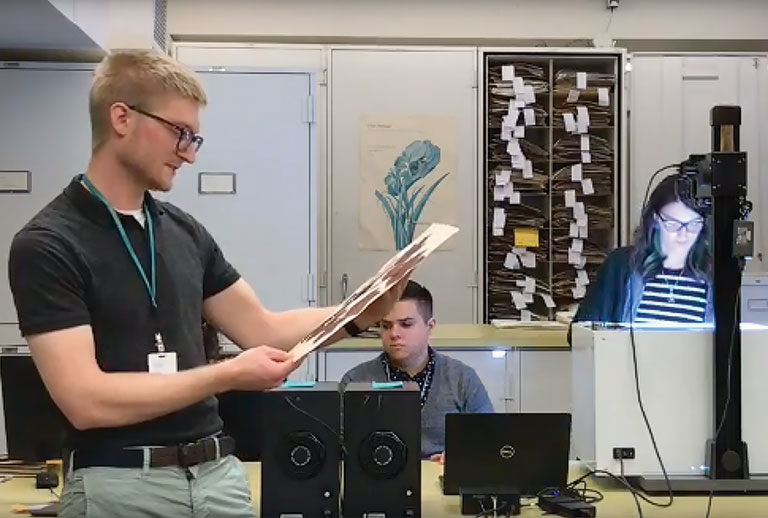
Mason Heberling, student Evan Moran, and curatorial assistant Sarah Williams in the herbarium doing the vital task of digitizing plant specimens.
All of which makes the team’s efforts to scan and digitize every sample in the herbarium all the more important. Isaac and Heberling were awarded a grant from the National Science Foundation to digitize nearly 200,000 of the museum’s specimens, joining a regional network of like-minded institutions. In a few years’ time, roughly a million specimens collected from New York City to Washington, D.C., to Pittsburgh will be accessible online to provide insights into the effects of centuries of urbanization. For some species, dried samples are all that remain.
“I think to understand our biological future, we need to understand what existed in the past and what currently exists.” – Mason Heberling
Amazingly, these preserved specimens can still offer scientists scores of information, including where the species lived, when, and why. Heberling also points to the way scientists can now extract genomic data from samples collected long before DNA had even been discovered. What’s more, in 2019 he published a proof-of-concept study showing that it’s possible to gather DNA not just from the plants in the collection but also from the fungi present within some plants’ roots. Known as mycorrhizae, these fungi form symbiotic relationships with many plant species, helping the plant better absorb water and nutrients while receiving carbohydrates in return. Heberling was able to glean root samples from plant specimens more than 100 years old, which means the herbarium may also unintentionally contain hundreds of thousands of invisible fungi specimens.
Flowers, leaves, and roots on these specimens all have scientific stories to tell. Old flowers have been used to track changes in when plants flower or even piece together pollinator networks by looking at pollen found on specimens. Old leaves have been used to understand how plant size or shape changes through time, across the world, or across species. Scientists sample leaves from specimens for chemical measurements, such as heavy metal concentrations, so that we can learn which species might be helpful in cleaning up toxic pollution.
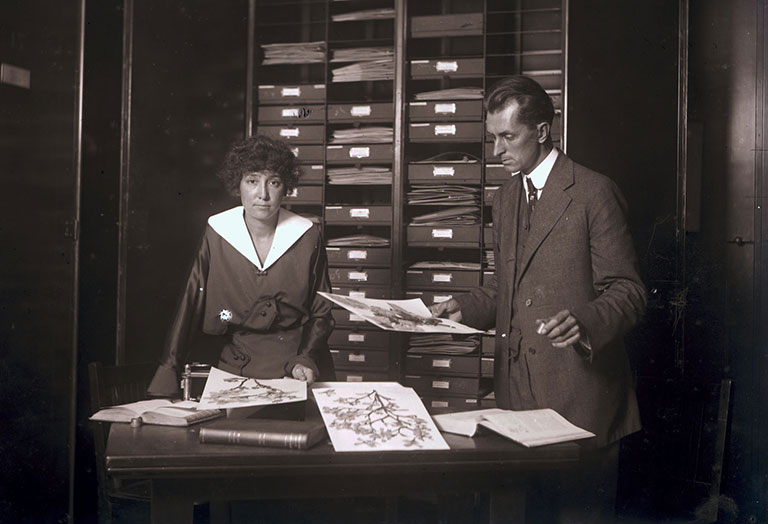
Grace and Otto Jennings in Carnegie Museum’s herbarium in 1912.
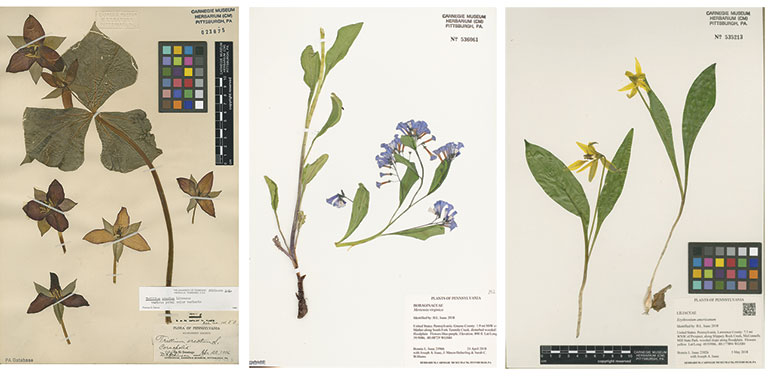
Red trillium collected in 1906 from Coraopolis; Virginia bluebells collected in 2018 from Greene County; Yellow trout lily collected in 2018 at McConnells Mill State Park.
Herbarium samples are also proving invaluable for tracking how environmental change is affecting the region. By using the information included in each specimen’s dossier, Isaac and Heberling have been returning to the sites where plants were collected anywhere from a decade to 100 years earlier. And museum staff will continue to visit them once every 10 years from now on. While the effort has only just begun, the forward-thinking idea has already yielded some fascinating results. For instance, the scientists have seen plants that were flowering 100 years ago when they were collected, but are now already fruiting instead. It’s as though the world is moving in fast-forward.
The herbarium also serves as a resource for other researchers. Samples are frequently mailed all over the world, and the digitization of each of its treasures and accompanying label data—a feat that consumed almost two decades of Isaac’s career—makes the specimens that much more accessible. Researchers also come and visit the collection in person, as Maura Flannery did last fall.
“The collection that we have is the best collection in the world for this region. It’s a record of the history of change.”
– Stephen Tonsor, Interim Director of Carnegie Museum of Natural History
In addition to being a professor emerita at St. John’s University and a research associate at the A.C. Moore Herbarium at University of South Carolina, Flannery is the author of the blog, Herbarium World. “I’m obsessed with herbaria,” says Flannery, who spends a good deal of her time visiting collections. She notes that there’s something special going on in Pittsburgh.
“Those two were really made for each other,” says Flannery of Isaac and Heberling. “They work so well together.”
She believes the effort to continuously go out and collect new specimens, not just manage old ones, is critical to the future of science. “Statistically, over the last 30 to 40 years, the amount of collecting is going down, and that’s something people are worried about.”
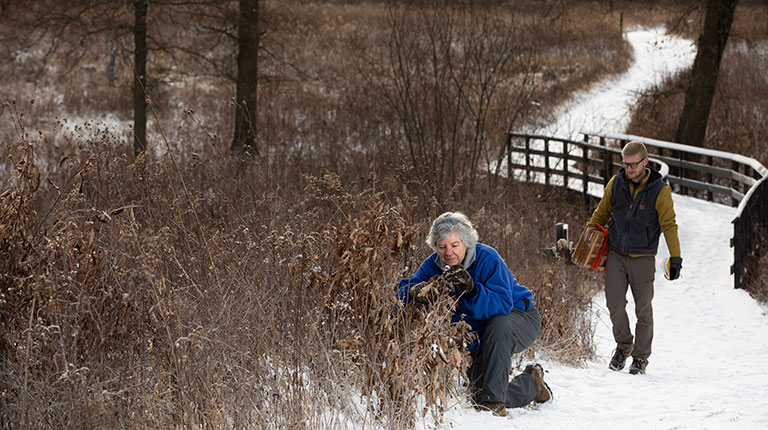
Photo: Joshua Franzos
For Stephen Tonsor, interim director of the museum, it’s impossible to undersell how important plants are for life on Earth. After all, we have early plants to thank for their ability to convert carbon dioxide to oxygen, which created the oxygen we breathe and our ozone layer.
“That ozone layer filters out the ultraviolet light that would otherwise break down our DNA faster than we could make it,” says Tonsor, who is also a botanist. “And so the fact that the first amphibians could crawl up onto the surface of the earth and out of the seas completely depends on there having been plant life.
“The collection that we have is the best collection in the world for this region,” says Tonsor. “It’s a record of the history of change.
“If we want oxygen in our atmosphere, if we want the food and fiber and shade and water-filtering that plants provide, we have to know what’s important to them.”



